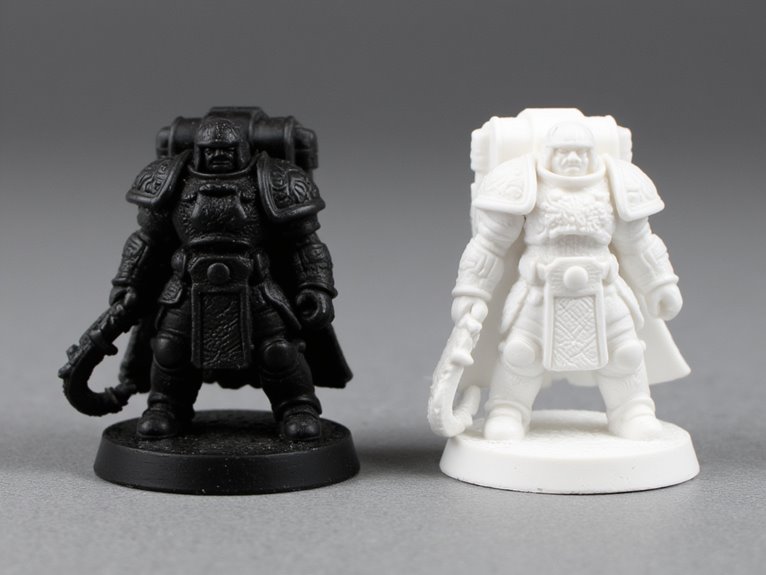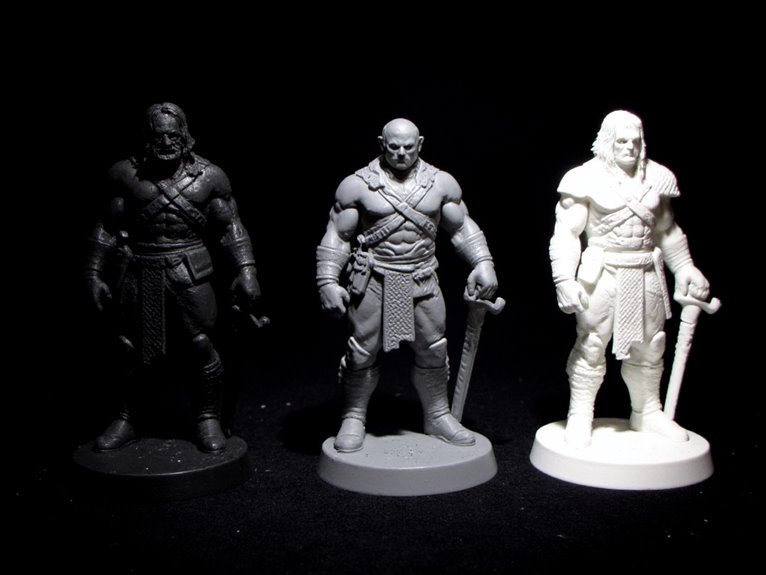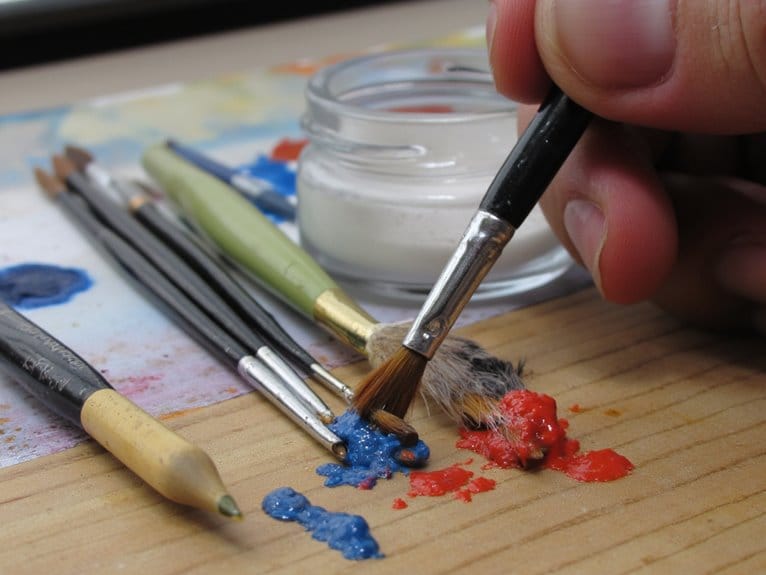We are supported by our audience. When you purchase through links on our site, we may earn an affiliate commission, at no extra cost for you. Learn more. Last update on 1st July 2025 / Images from Amazon Product Advertising API.
You’ll achieve brighter, more vibrant colors with white primer since it reflects light and enhances saturation, making it ideal for colorful schemes and detailed work. Black primer creates natural shadows and depth but mutes colors, requiring more coats for lighter hues. However, it excels with dark palettes and metallics. Grey primer offers the best balance, maintaining true color representation without the extremes of either option. Understanding each primer’s specific applications will transform your painting technique.
Notable Insights
- White primer enhances color vibrancy and requires fewer layers for bright colors, making details more visible during painting.
- Black primer creates natural shadow effects and depth but requires more coats when applying lighter or brighter colors.
- White primer works best for bright color schemes and metallics, while black primer suits dark, moody palettes better.
- Black primer conceals painting mistakes and surface imperfections, whereas white primer reveals errors that need thorough coverage.
- Grey primer offers a balanced compromise, providing color accuracy and versatility for both light and dark schemes.
Visual Impact and Color Brightness Comparison
When you’re selecting primer for your miniatures, the color choice fundamentally alters how every subsequent paint layer appears on the model.
White primer creates a brighter, more vibrant base that enhances light colors and maintains true hues. Your yellows, reds, and whites will pop with minimal layering.
Black primer produces a darker, moodier foundation that mutes colors and creates natural shadows from the start.
This choice directly impacts your color theory application and artistic expression.
White primer acts like built-in lighting, improving light-to-shadow shifts but requiring additional washes for depth.
Black primer provides inherent shadow depth while demanding more layers for bright colors. Black primer also significantly improves metallic paints, enhancing their reflective properties and overall finish quality.
Grey primer offers a neutral midpoint between these extremes, though it’s less commonly used for brightness comparisons. Both black and white primers offer superior adhesion across various miniature materials including plastic, metal, and resin.
White primer provides better visibility of miniature details during painting, making it easier to identify areas that require attention.
Detail Visibility and Painting Ease

Beyond color impact, primer choice greatly affects how well you’ll see fine details and how smoothly your painting process flows.
White primer creates a bright background that enhances surface detail visibility, making precise application easier for lighter colors. You’ll need fewer layers to achieve color saturation with bright hues.
White primer maximizes detail visibility and reduces paint layers needed for vibrant, lighter colors.
Black primer initially obscures fine details, creating painting challenges that require careful scrutiny during application. However, it simplifies dark color coverage and provides natural shading effects for depth visualization.
Grey primer offers balanced detail management between the extremes.
White primer makes errors more obvious, demanding thorough coverage attention. Black primer conceals some mistakes naturally but may require additional skill for lighter color layering.
Your detail work precision depends greatly on matching primer choice to your painting style and experience level.
Investing in specialized brush sets with detail brushes can significantly improve your ability to work with challenging primer-paint combinations and achieve professional-quality results.
Shading and Highlighting Techniques
Your primer choice fundamentally shapes how shadows and highlights develop on your miniature’s surface.
Black primer creates natural shadow effects by leaving recesses dark, while white primer requires additional work to establish convincing shadows in those same areas.
You’ll find that highlighting over black demands more layers and effort, whereas white primer makes highlights pop with minimal paint application. This contrast between highlighted areas and shaded recesses achieves a three-dimensional look that enhances details and depth on your miniatures.
Since shadows need careful exaggeration on small figures to be effective, your primer selection becomes even more critical for achieving the visual impact necessary to make details stand out. For painters seeking the ultimate in precision control over these subtle gradations, dual-action airbrushes offer superior paint application compared to traditional brushing methods.
Natural Shadow Effects
Since miniatures operate at a scale where natural lighting laws work against realistic shadow formation, you’ll need to artificially create the depth that larger objects display naturally. The inverse square law dramatically reduces shadow intensity on small-scale figures, requiring forced shadow techniques to compensate.
Black primer establishes this foundation by providing inherent darkness in recesses. When you spray white primer from above during zenithal priming, you create realistic shadow play across the miniature’s surface. This method mimics how natural light falls on full-sized objects.
The gradient between black shadows and white highlights enhances three-dimensional appearance before you apply any paint. This color interplay gives your miniature realistic depth perception that would otherwise be lost at miniature scale without artificial enhancement. Two-tone priming with black and white enhances contrast for more dramatic lighting effects. Front and back lighting choices determine how consistent your shadows appear when viewers examine the miniature from different angles.
Highlighting Effort Requirements
While zenithal priming creates natural shadow depth, your highlighting workflow changes dramatically based on primer choice.
White primer streamlines highlighting techniques by providing immediate visibility of miniature details and edges. You’ll need fewer paint layers to achieve bright highlights since the light base tone naturally enhances color vibrancy.
Black primer demands more intensive layering and dry brushing to build highlights gradually from darkness.
The effort comparison reveals stark differences in time investment. White-primed models let you apply highlights directly with minimal buildup, while black primer requires multiple thin coats to achieve desired brightness.
You’ll spend considerably more time raising dark colors to proper luminosity.
However, white primer complicates shadow work—you must compensate with precise washes to maintain depth in recesses that would naturally remain dark on black primer. Black primer allows gradual highlighting from dark to lighter colors while naturally enhancing the depth of shadows and contrasts.
Color Scheme Suitability
Your color scheme drives primer selection more than any other factor in miniature painting.
Bright palettes featuring reds, yellows, and vibrant blues perform best over white primer, which provides the light base necessary for maximum color saturation and reduces the layers needed to achieve full coverage.
Dark schemes with blacks, deep grays, and muted earth tones benefit from black primer that establishes natural shadows and creates depth in recesses without additional work.
When selecting paints for your chosen scheme, consider high-quality acrylic paints that offer excellent pigmentation and opacity to work effectively with your primer choice.
Bright Vs Dark Palettes
Although primer color might seem like a minor detail, it fundamentally affects how your paint colors appear on the finished miniature. Your color selection determines which primer delivers superior results.
White primer enhances bright palettes by providing a reflective base that maintains true color vibrancy. Yellows, whites, and reds show their intended hues without dulling or requiring multiple layers.
Black primer excels with dark palette preferences, naturally deepening shadows and enriching blacks, browns, and deep greens. Dark colors appear richer over black surfaces while requiring fewer coats to achieve full coverage.
Grey primer offers balanced performance for mixed schemes, reducing paint consumption for both bright and dark tones while maintaining adequate contrast without overwhelming lighter colors.
Metallic and Natural Tones
Metallic and natural tone color schemes present unique challenges that demand careful primer selection based on your specific paint choices.
Black primer excels with darker metallics like gunmetal and bronze, providing inherent color depth that reduces metallic layering requirements. You’ll achieve better finish consistency with fewer coats since shadows are pre-established.
Natural vibrancy suffers over black primer, requiring additional build-up for skin tones and earth colors.
White primer maximizes brightness in gold and silver metallics but complicates shading work.
Grey primers offer balanced primer effects for both schemes, moderating extreme contrast while preserving detail visibility.
- Black primer simplifies metallic layering but obscures natural tone details initially
- White primer enhances metallic brightness yet increases layering complexity for proper depth
- Grey primers provide ideal aesthetic choices by balancing visibility with natural shadow depth
Coverage and Opacity Performance
When selecting primer for your miniatures, the choice between black and white directly impacts how efficiently your paints will cover and how vibrant they’ll appear on the finished model.
White primer requires fewer paint layers to achieve full opacity because it reflects light and maintains color brightness. Your spray technique affects coverage uniformity regardless of primer type.
Black primer demands additional coats for bright colors like reds and yellows, as the dark base dulls their vibrancy. However, black excels with darker palettes, where the underlying color complements shadow areas and reduces painting time.
White primer enhances translucency effects for glazing techniques, while black produces richer depth and contrast. Surface texture after priming impacts paint adhesion consistency for both options.
Professional airbrushes with 0.35mm nozzles deliver exceptional versatility for applying primer, allowing for both ultra-fine detail work and broader coverage patterns on miniature surfaces.
Painter Workflow and Preferences
Beyond coverage considerations, your primer choice fundamentally shapes how you’ll approach each painting session and which techniques you’ll employ throughout the process.
White primer enhances workflow efficiency by revealing surface flaws early, allowing corrections before paint application begins. You’ll need more careful brush control to prevent overwhelming highlights.
White primer reveals surface imperfections immediately, enabling early corrections but demanding precise brush control to avoid overpowering highlights.
Black primer masks minor imperfections but requires stronger highlighting techniques to bring out details from deep shadows.
- Primer layering technique: Apply multiple thin coats at 15-20 cm distance rather than single thick applications to preserve miniature details
- Error detection timing: White primer exposes mistakes immediately while black primer camouflages them until later stages
- Technique adaptation: Black primer demands intermediate tone building before final highlights, while white primer supports transparent layering methods
Your primer selection directly influences blending requirements and glazing frequency throughout the entire painting process.
Grey Primer as the Middle Ground Alternative

Many painters discover grey primer delivers superior color accuracy without the extreme contrast effects of black or white alternatives. You’ll find grey primer advantages include neutral tonal balance and enhanced color fidelity. This primer prevents the darkening effects of black bases while avoiding white’s brightness shifts.
| Aspect | Grey Primer Performance |
|---|---|
| Color Accuracy | Maintains true color representation |
| Coverage | Requires fewer correction layers |
| Versatility | Works with light and dark schemes |
| Application | Compatible with airbrush techniques |
The middle-ground approach supports subtle shading techniques and smoother shifts. You can build layers more effectively on grey’s balanced base tone. However, grey primer disadvantages include potentially slower coverage compared to stark contrast primers in certain lighting conditions.
On a final note
You’ll find that neither black nor white primer universally outperforms the other. Your choice depends on your specific project requirements and painting style. White primer enhances bright colors and speeds up highlighting workflows. Black primer improves shadow contrast and works better with darker color schemes. Grey primer offers balanced performance for most applications. Consider your miniature’s intended color palette, your experience level, and preferred painting techniques when selecting primer. Test different options to determine what works best for your workflow.



